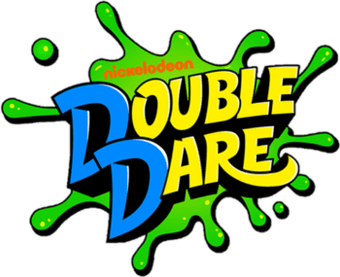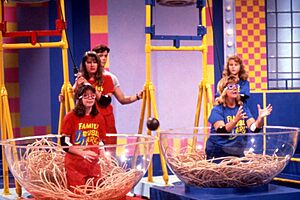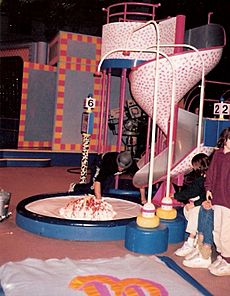Double Dare (franchise) facts for kids
Quick facts for kids Double Dare |
|
|---|---|

Logo for the 2018 revival
|
|
| Genre | Game show |
| Created by |
|
| Written by |
|
| Directed by |
|
| Presented by |
|
| Narrated by |
|
| Theme music composer |
|
| Country of origin | United States |
| Original language(s) | English |
| No. of episodes |
|
| Production | |
| Executive producer(s) |
|
| Producer(s) |
|
| Production location(s) |
|
| Running time | 22–24 minutes |
| Production company(s) |
|
| Distributor |
|
| Release | |
| Original network |
|
| Picture format | |
| Original release |
|
Double Dare is a super fun American game show where two teams battle it out! They answer tricky trivia questions and complete messy, wild challenges called "physical challenges." Teams win cash and awesome prizes.
The show first aired on Nickelodeon on October 6, 1986. It was Nickelodeon's very first game show! Marc Summers was the host for many years. Double Dare quickly became super popular. It helped make Nickelodeon a big name in TV and brought back game shows for kids. It's still Nickelodeon's longest-running game show! In 2001, TV Guide even called it one of the 50 Greatest Game Shows.
Over the years, Double Dare had different versions. Super Sloppy Double Dare started in 1989. Family Double Dare began in 1988, letting families play together. The original show ended in 1993. Then, it came back! Double Dare 2000 aired with Jason Harris as host. The most recent version, hosted by Liza Koshy with Marc Summers, ran from 2018 to 2019.
Contents
How to Play Double Dare
The Main Game Rules
In the original Double Dare and Super Sloppy Double Dare, each team had two kids. For Family Double Dare and Double Dare 2000, teams had two adults and two kids. Teams used to wear red, but later one team wore red and the other wore blue.
Each round starts with a "toss-up" physical challenge. Both teams compete in this messy challenge. The team that wins gets to start the round and earns some money.
Next, the host asks trivia questions. If a team answers correctly, they get money and keep control. If they answer wrong, or don't answer fast enough, the other team gets a chance.
But here's the fun part! A team can "dare" their opponents to answer a question. This doubles the money for that question! The opponents can then "double dare" back, making the question worth four times the original amount! If a team is double dared, they must either answer the question or do a physical challenge. If they fail a dare or double dare, the other team gets the money and control.
Question values changed over time. In the original show, a question was worth $10. In Family Double Dare and Double Dare 2000, it was $25. The 2018 Double Dare started with $50 per question, later changing to 50 points.
Messy Physical Challenges
Physical challenges are often super messy stunts! A team has to finish the stunt in a set time, usually 20 or 30 seconds. If they complete it, they win money and keep control of the game. If they don't, the money and control go to the other team.
Many challenges involve filling a container with gooey stuff like water, rice, green slime, or whipped cream. Other stunts might have you catching items before time runs out. For example, in "Pies in the Pants," one player catches pies in giant clown pants while their teammate launches them!
In the original Double Dare, both players on a team did every challenge. In Family Double Dare, all four team members might compete. In later versions, sometimes two players did the challenges, and sometimes all four.
Double Dare 2000 added the "Triple Dare Challenge." In round two, a team could make their physical challenge even harder. This would add $100 to its value and put a bonus prize on the line! The challenge might get a shorter time limit or an extra task. If the team failed, they lost the money, prize, and control.
The Awesome Obstacle Course
The team with the most money at the end of round two gets to run the famous obstacle course! (It was called the Slopstacle Course for Double Dare 2000.) In most versions, both teams kept all the money they earned. Only the winning team on the 2018 show kept their money.
The course has eight obstacles that must be completed in 60 seconds. Each obstacle has a hidden orange flag. One team member runs the first obstacle and grabs its flag. Then, they pass the flag to their partner, who runs the next obstacle. They keep switching until they finish all eight or time runs out. Players wear helmets and pads to stay safe.
Many obstacles are super creative and messy! They often look like giant body parts, food, or everyday items. Some popular ones include:
- The One-Ton Human Hamster Wheel: A huge hamster wheel you run inside.
- Pick It: A giant human nose with a flag inside!
- The Sundae Slide: A chocolate-covered ramp leading to a playground slide into a pool of "ice cream."
- Gum Drop: You jump into a giant gumball machine filled with plastic balls and slide out.
Teams used to win a prize for each obstacle they completed. The prizes got better and better, leading to a grand prize for finishing the whole course! Prizes included TVs, concert tickets, electronics, and even vacations. On the Fox Family Double Dare, the grand prize was a car!
In the 2018 revival, the obstacle course offered $500 cash for each obstacle completed. The total jackpot for finishing the course was $5,000!
Double Dare Beyond the Show
Cool Merchandise and Live Tours
Double Dare was so popular that it led to lots of cool stuff! Reebok was a big sponsor, so all contestants and crew wore their shoes.
From 1987 to 1995, Double Dare had live tours all over the United States. Fans could come and even participate in challenges, just like on TV! These tours were a huge hit, with some events selling out arenas with over 20,000 people! The tours came back for Double Dare 2000 and again in 2018, with Marc Summers hosting.
You could also buy Double Dare board games from Pressman Toy Corporation and Mattel. GameTek made a PC game and a video game for the Nintendo Entertainment System. There were even Double Dare game books!
And of course, the slime! Mattel and Jakks Pacific made toy slimes called Gak and Goooze, inspired by the messy substances on the show. You could also find Double Dare toys, clothes, lunchboxes, and school supplies.
In 2016, a New York store called STORY had a "Remember When" event featuring Double Dare. You could buy special T-shirts and even try out the One-Ton Human Hamster Wheel obstacle!
Watching Double Dare Today
You can still watch Double Dare episodes! Some highlights and special features were released on home video in the past.
Today, you can find episodes of Super Sloppy Double Dare and Family Double Dare to buy online on Amazon Prime Video and the iTunes Store. An episode of both was also on a DVD called Nickelodeon Games and Sports: All-Star Collection.
Many episodes of the original Double Dare are available on the NickHits channel, which you can find on Prime Video and Apple TV. They were also added to Paramount+ in 2021. Recent versions of the show are on Pluto TV.
If you want to play, a Double Dare game was released on Facebook Messenger in 2018. You can play against your friends or other Messenger users!
Images for kids







